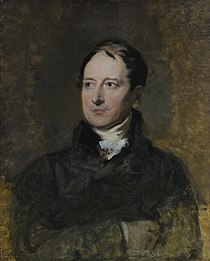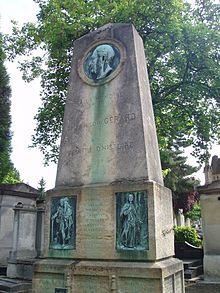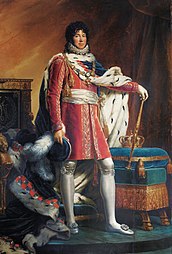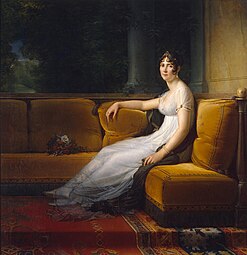François Gérard
Francois Gérard | |
|---|---|
 Francois Gérard aged 54, by Sir Thomas Lawrence | |
| Born | François Pascal Simon Gérard 12 March 1770[a] |
| Died | 11 January 1837 (aged 66) |
| Nationality | French |
| Education | Pajou, Brenet, David |
| Known for | Portrait painting |
François Pascal Simon Gérard (French pronunciation: [fʁɑ̃swa paskal simɔ̃ ʒeʁaʁ], 4 May 1770 – 11 January 1837),[a] titled as Baron Gérard in 1809, was a prominent French painter. He was born in Rome, where his father occupied a post in the house of the French ambassador, and his mother was Italian. After he was made a baron of the Empire in 1809 by Emperor Napoleon, he was known formally as Baron Gérard.
Life and career
François Gérard was born in Rome to J. S. Gérard and Cleria Matteï.[1] At the age of twelve, Gérard obtained admission into the Pension du Roi in Paris. From the Pension, he passed to the studio of the sculptor Augustin Pajou, which he left at the end of two years for the studio of the history painter Nicolas-Guy Brenet,[2] whom he quit almost immediately to place himself under Jacques-Louis David.[3]
In 1789, he competed for the Prix de Rome, which was carried off by his comrade Girodet. In the following year (1790), he again presented himself, but the death of his father prevented the completion of his work and obliged him to accompany his mother to Rome. In 1791, he returned to Paris, but his poverty was so great that he was forced to forgo his studies in favor of employment which would bring in immediate profit. David at once availed himself of his help, and one of that master's most celebrated portraits, of Louis-Michel Le Pelletier de Saint-Fargeau, may owe much to the hand of Gérard. This painting was executed early in 1793, the year in which Gérard, at the request of David, was named a member of the revolutionary tribunal, from the fatal decisions of which he, however, invariably absented himself.[4]

In 1794, he obtained the first prize in a competition, the subject of which was The Tenth of August, that is, the storming of the Tuileries Palace. Further stimulated by the successes of his rival and friend Girodet in the Salons of 1793 and 1794, Gérard (aided by Jean-Baptiste Isabey, the miniaturist) produced in 1795 his famous Bélisaire. In 1796, a portrait of his generous friend (conserved today in the Louvre) obtained undisputed success, and the money received from Isabey for these two works enabled Gérard to execute in 1797 his Psyche et l'Amour (illustration).[b] At last, in 1799, his portrait of Madame Mère established his position as one of the foremost portrait-painters of the day.[4]
In 1808, as many as eight (and in 1810, no less than fourteen) portraits by him were exhibited at the Salon, and these figures afford only an indication of the enormous numbers which he executed yearly. All of the leading figures of the Empire and of the Bourbon Restoration, and all of the most celebrated men and women of Europe, sat for Gérard. This extraordinary vogue was due partly to the charm of his manner and conversation, for his salon was as much frequented as his studio. Madame de Staël, George Canning, Talleyrand and the Duke of Wellington have all borne witness to the attraction of his society.[4]
Rich and famous, Gérard was stung by remorse for earlier ambitions abandoned; at intervals, he had indeed striven with Girodet and other rivals to prove his strength at history painting, still a more prestigious genre than portraiture. His Bataille d'Austerlitz (1810) showed a breadth of invention and style which was even more conspicuous in L'Entrée d'Henri IV à Paris (at Versailles), the work with which in 1817 he paid homage to the returned Louis XVIII. After this date, Gérard declined, watching with impotent grief the progress of the Romantic school.[4]
Loaded with honors – baron of the Empire in 1809, member of the Institut on 7 March 1812, officer of the Légion d'honneur, first painter to the king – he worked on, sad and discouraged. The revolution of 1830 added to his disquiet, and on 11 January 1837, after three days of fever, he died.[4]
Gérard is best remembered for his portraits. The color of his paintings has suffered, but his drawings show in uninjured delicacy the purity of his line, and those of women are specially remarkable for a virginal simplicity and frankness of expression.[4] His students included Heinrich Christoph Kolbe.
Selected works
-
Napoleon Bonaparte as First Consul, 1803
-
Portrait of Joachim Murat, king of Naples and of the Two Sicilies, 1811–1812, private collection, Paris
-
Portrait of Emperor Napoleon I
-
Portrait of Madame Récamier
-
Portrait of Empress Joséphine
-
Portrait of Désirée Clary
-
Portrait of Catherine Grand, Princesse de Bénévent
-
Portrait of Hortense de Beauharnais
-
Portrait of Hortense de Beauharnais
-
Napoleon at the Battle of Austerlitz
-
Corinne at Cape Misenum, 1819–1821, Musée des Beaux-Arts de Lyon
-
Daphnis and Chloe, c. 1824, oil on canvas, The Detroit Institute of Arts
-
Mme de Staël as her character Corrine (posthumously)
See also
Footnotes
- ^ a b Some sources say he was born on 4 May 1770, however his tombstone (Montparnasse Cemetery, 1st division) reads: "Ici reposent – François Pascal Simon baron Gérard, né à Rome le 12 mars 1770, mort à Paris le 11 janvier 1837 – Jacques Alexandre Gérard, né à Paris le 13 avril 1780, mort à Paris le 28 octobre 1832 – Marguerite Françoise Matteï, [épouse] de F. Gérard, née à Rome le 7 avril 1775, morte à Auteuil le 1er décembre 1848 – Sophie Catherine Sylvoz, [épouse d'Alexandre] Gérard, née à Chambéry le 8 [octobre] 1792, morte à Paris le 16 mars 1867 – La famille à leur mémoire chère."
- ^ At the Hong Kong Book Fair 2007, Hong Kong's Television and Entertainment Licensing Authority forced the publisher of a Chinese book, translated from Korean, Love Mythology: Love Stories in Greek and Roman Mythology: 12 Keys to Understand Myths of Love Theme (Author: Lee Eyun Kee Publisher: [Taiwan] Yuan Liou) bearing Gérard's "Psyché et l'Amour" on the cover to temporarily withdraw it from sale.
References
Sources
- This article incorporates text from a publication now in the public domain: Chisholm, Hugh, ed. (1911). "Gérard, François". Encyclopædia Britannica. Vol. 11 (11th ed.). Cambridge University Press. pp. 764–765.
- Lenormant, Charles (1847). François Gérard, peintre d'histoire: essai de biographie et de critique (2nd ed.). Paris: Adolphe René et compagnie. Retrieved 10 May 2009. A biography by Charles Lenormant.
- Gérard, Henri; Viollet-le-Duc, Adolphe (1867). Correspondance de François Gérard: peintre d'histoire, avec les artistes et les personnages célèbres de son temps. Paris: Adolphe Lainé et J. Havard. Retrieved 10 May 2009. A biography by Adolphe Viollet-le-Duc followed by François Gérard's correspondence collected by his nephew Henri Gérard.
- Gérard, Henri (1888). Lettres adressées au baron François Gérard, peintre d'histoire, par les artistes et les personnages célèbres de son temps (3rd ed.). Paris: A. Quentin. Retrieved 10 May 2009. A different biography by his nephew Henri Gérard, 14 etched portraits, additional letters and notes.
Notes
- ^ Henri Gérard 1888
- ^ Nicolas-Guy Brenet (1728–1792), professor at the Académie royale de peinture et de sculpture, 1778. Michael Bryan, Dictionary of Painters and Engravers, s.v. "Brenet, Nicolas Guy". Brenet was also the master of Jean Germain Drouais.
- ^ Chisholm 1911, pp. 764–765.
- ^ a b c d e f Chisholm 1911, p. 765.
External links
 Corinne at the Cape of Misena., the painting of 'Mme de Staël as her character Corrine' engraved by Joseph Goodyear for The Amulet annual, 1832.
Corinne at the Cape of Misena., the painting of 'Mme de Staël as her character Corrine' engraved by Joseph Goodyear for The Amulet annual, 1832.
- 18th-century French painters
- French male painters
- 19th-century French painters
- 1770 births
- 1837 deaths
- Pupils of Jacques-Louis David
- Members of the Académie des beaux-arts
- Burials at Montparnasse Cemetery
- Artists from Paris
- French people of Italian descent
- Barons of the First French Empire
- Officiers of the Légion d'honneur
















